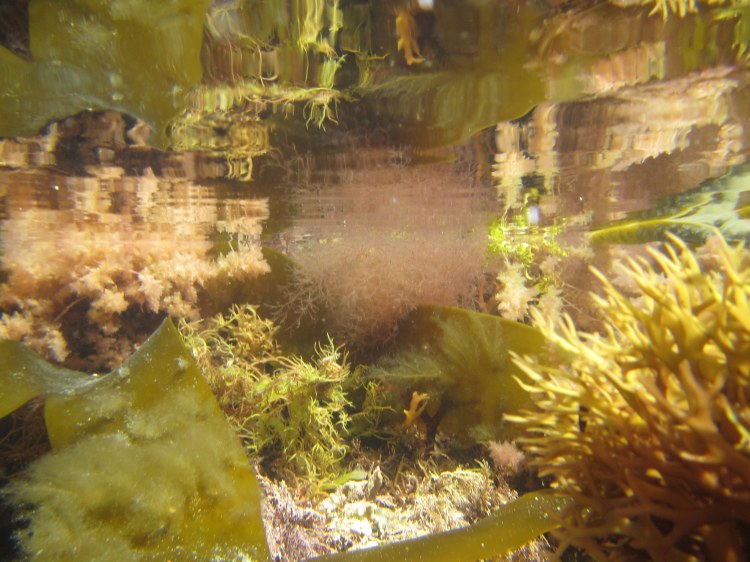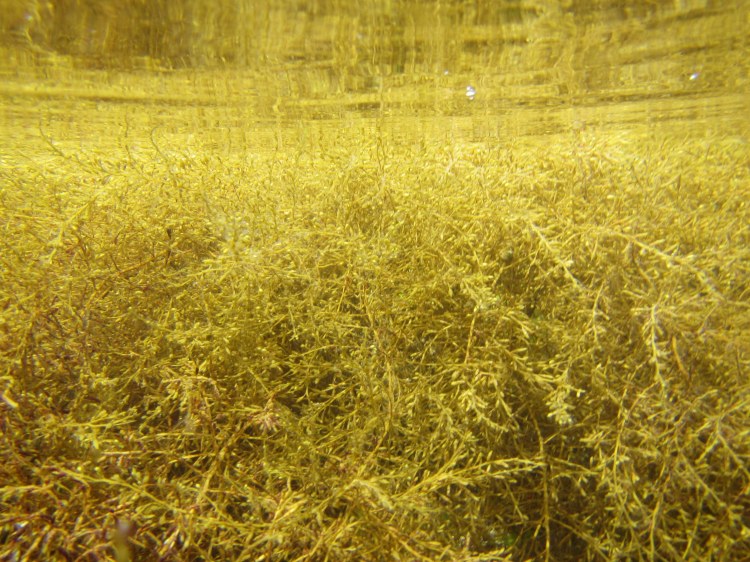 Quick post about an hour worth of snorkelling on Wednesday. Very frustratingly, I had a housing mishap on Saturday, meaning my brandnew Olympus camera and lens got wet. $%&^”! as the saying goes…..I have sent both back for repair and hope all can be fixed relatively fast and cheap. A minor disaster but what can you do? Go out with my old Canon Powershot and wetlens instead I guess! The viz was not the greatest but I can only blame myself for a disappointing haul of photos. I took around 200 (as usual), whittled them down to 75 or so on my camera afterwards and then to 30 or so on my computer. Did some tweaking in ‘Photos’ afterwards but they were 5’s, 6’s and 7’s at most. The midshore pools were looking pretty. Lots of one of my favourite seaweed species Slender-beaded Coral Weed Jania rubens growing on top of (mostly) Hairy sandweed (and possibly Black scour weed). Lots of other epiphytic species grow on top of this assemblage, including Sea lettuce Ulva, Brown fan weed Dictyota dichotoma, Gelidium spp, Ceramium spp, Colpomenia OR Leathisia (I still am not sure of the difference..) and many others.
Quick post about an hour worth of snorkelling on Wednesday. Very frustratingly, I had a housing mishap on Saturday, meaning my brandnew Olympus camera and lens got wet. $%&^”! as the saying goes…..I have sent both back for repair and hope all can be fixed relatively fast and cheap. A minor disaster but what can you do? Go out with my old Canon Powershot and wetlens instead I guess! The viz was not the greatest but I can only blame myself for a disappointing haul of photos. I took around 200 (as usual), whittled them down to 75 or so on my camera afterwards and then to 30 or so on my computer. Did some tweaking in ‘Photos’ afterwards but they were 5’s, 6’s and 7’s at most. The midshore pools were looking pretty. Lots of one of my favourite seaweed species Slender-beaded Coral Weed Jania rubens growing on top of (mostly) Hairy sandweed (and possibly Black scour weed). Lots of other epiphytic species grow on top of this assemblage, including Sea lettuce Ulva, Brown fan weed Dictyota dichotoma, Gelidium spp, Ceramium spp, Colpomenia OR Leathisia (I still am not sure of the difference..) and many others. 





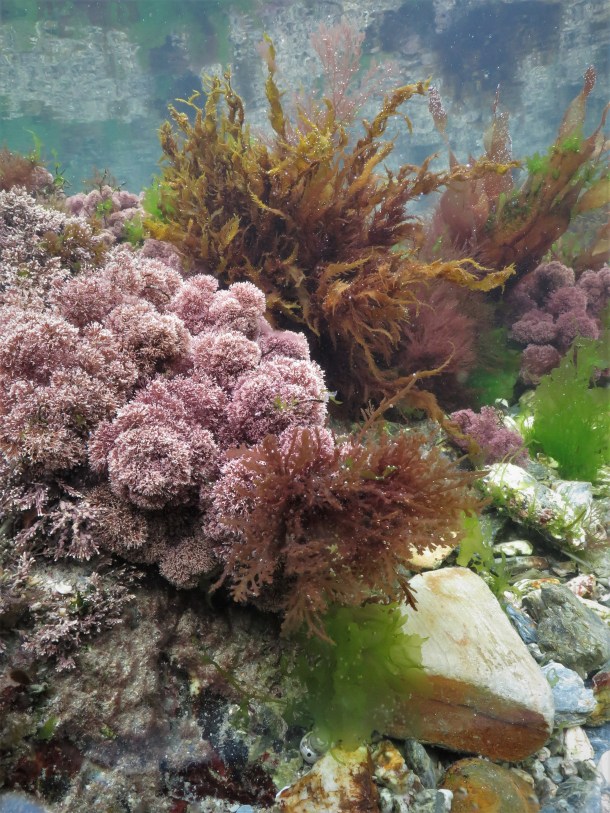
Category Archives: Canon Powershot D30
more diving
 Last Wednesday I went for a quick dive at Silver Steps in Falmouth, good viz and the water is no longer cold. Buddy Chris (above) and I rummaged around the U-boat wreckage (less impressive than it sounds) and unfortunately did not see any cuttlefish. What was new was a largish Topknot Zeugopterus punctatus which was gone before I could take a decent photo. I also saw seacucumbers for the first time diving (have seen them before when rock pooling, including parasitic snails). They could be Pawsonia or Aslia, but with the bodies wedged in the rocks and only the feeding tentacles visible it is not possible to tell. Sand eels were abundant and Sand smelt Atherina presbyter were also present at the surface. I hope to go back soon to practice with the strobe. I did a second dive in Flushing with Thomas too. Enjoyable but not too many great shots. I included one of Sand mason worms Lanice conchilega and fan worms Megalomma vesiculosum.
Last Wednesday I went for a quick dive at Silver Steps in Falmouth, good viz and the water is no longer cold. Buddy Chris (above) and I rummaged around the U-boat wreckage (less impressive than it sounds) and unfortunately did not see any cuttlefish. What was new was a largish Topknot Zeugopterus punctatus which was gone before I could take a decent photo. I also saw seacucumbers for the first time diving (have seen them before when rock pooling, including parasitic snails). They could be Pawsonia or Aslia, but with the bodies wedged in the rocks and only the feeding tentacles visible it is not possible to tell. Sand eels were abundant and Sand smelt Atherina presbyter were also present at the surface. I hope to go back soon to practice with the strobe. I did a second dive in Flushing with Thomas too. Enjoyable but not too many great shots. I included one of Sand mason worms Lanice conchilega and fan worms Megalomma vesiculosum.




Falmouth Seaweeds: January
 As I noticed that the rock pools have started to look really pretty, I have gone out snorkelling four times the last week to photograph seaweeds. Bitterly cold (around 10°C) but worth it! It is my aim to post photo’s taken at the same spot every month this year, let’s see. The first three days the tide was very low, making it more of a lying on the sand rather than actual snorkelling. The sun was out and my main challenge was to get to grips with overexposure, checking histograms and decreasing image brightness. The other main challenge is to not stir the sand up and create ‘marine snow’. It makes a world of difference to actually stick your head underwater and look through the viewfinder instead of lazily only submerging the camera. For now, I have only cropped and adjusted contrast of jpegs using Picasa, but I have also shot in raw format and hope to get more out of the shots in the near future. With help from the excellent Seasearch Guide to Seaweeds of Britain and Ireland and the Seaweeds of the NE Atlantic facebook page some of the species could be identified.
As I noticed that the rock pools have started to look really pretty, I have gone out snorkelling four times the last week to photograph seaweeds. Bitterly cold (around 10°C) but worth it! It is my aim to post photo’s taken at the same spot every month this year, let’s see. The first three days the tide was very low, making it more of a lying on the sand rather than actual snorkelling. The sun was out and my main challenge was to get to grips with overexposure, checking histograms and decreasing image brightness. The other main challenge is to not stir the sand up and create ‘marine snow’. It makes a world of difference to actually stick your head underwater and look through the viewfinder instead of lazily only submerging the camera. For now, I have only cropped and adjusted contrast of jpegs using Picasa, but I have also shot in raw format and hope to get more out of the shots in the near future. With help from the excellent Seasearch Guide to Seaweeds of Britain and Ireland and the Seaweeds of the NE Atlantic facebook page some of the species could be identified. 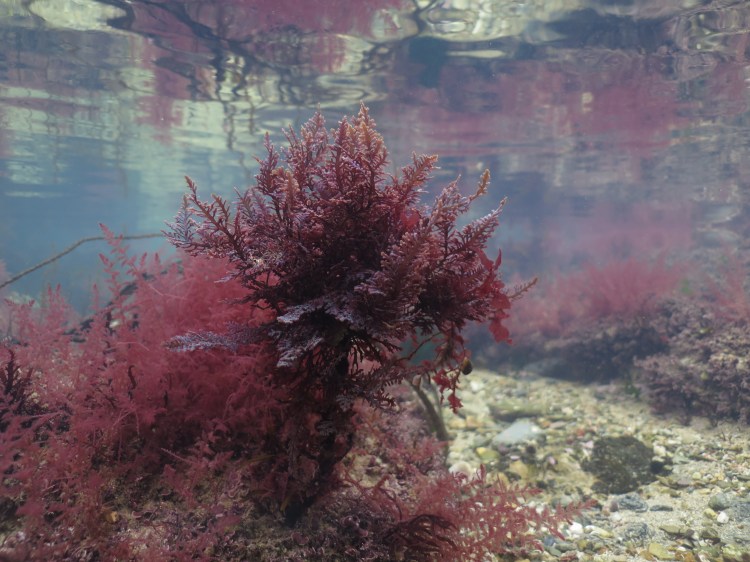
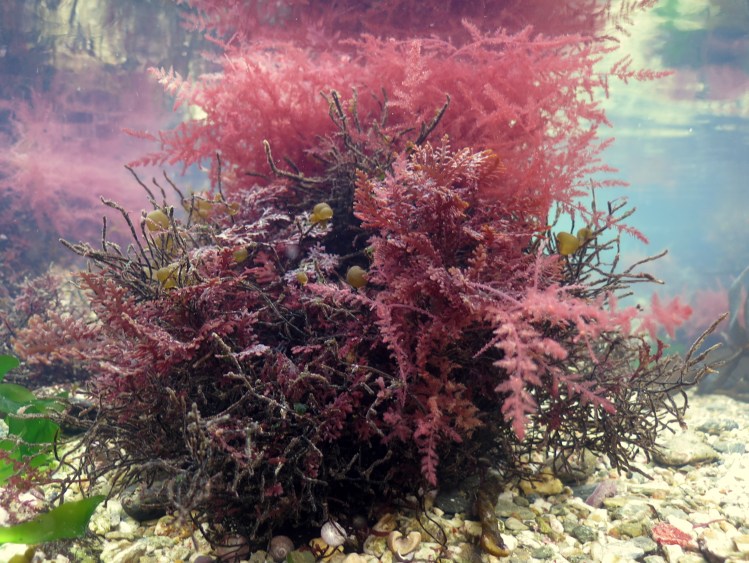
 Above, Osmundea osmunda (probably), which has a very nice blueish (‘glaucus’) tinge (I need to take some close-ups of that next time). In the following photo, a whole tangle of species, mainly Hairy sand weed Cladostephus spongiosus, with Osmundea, Asparagopsis, Bonnemaisonia and Leathesia. Next, another picture of a whole variety of species, I would like to find out what the red epiphyte is. Below some photos of individual species of red seaweeds (mostly not great but it gives an idea of the diversity). First, Leafy rose weed Rhodophyllis divaricata, next Falkenbergia (which is actually not a species but a distinct phase in the life cycle of Harpoonweed Asparagopsis Armata), Berry wart cress Sphaerococcus coronopifolius, Irish moss Chondrus crispus, Beautiful fan weed Callophyllis laciniata, Under tongue weed Hypoglossum hypoglossoides, Chondrus with Falkenbergia and Hypoglossum and Plocamium on top and a small unknown species. You can see that most photos suffer from overexposure (and notice my crude upped contrasts).
Above, Osmundea osmunda (probably), which has a very nice blueish (‘glaucus’) tinge (I need to take some close-ups of that next time). In the following photo, a whole tangle of species, mainly Hairy sand weed Cladostephus spongiosus, with Osmundea, Asparagopsis, Bonnemaisonia and Leathesia. Next, another picture of a whole variety of species, I would like to find out what the red epiphyte is. Below some photos of individual species of red seaweeds (mostly not great but it gives an idea of the diversity). First, Leafy rose weed Rhodophyllis divaricata, next Falkenbergia (which is actually not a species but a distinct phase in the life cycle of Harpoonweed Asparagopsis Armata), Berry wart cress Sphaerococcus coronopifolius, Irish moss Chondrus crispus, Beautiful fan weed Callophyllis laciniata, Under tongue weed Hypoglossum hypoglossoides, Chondrus with Falkenbergia and Hypoglossum and Plocamium on top and a small unknown species. You can see that most photos suffer from overexposure (and notice my crude upped contrasts).
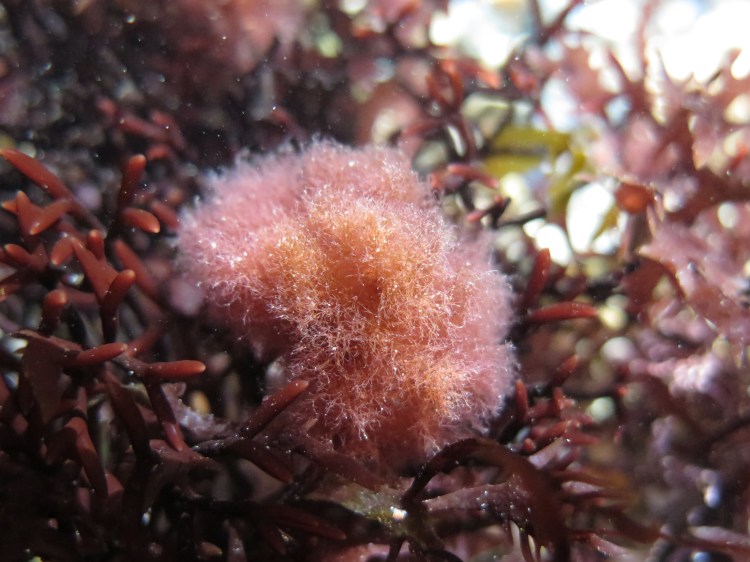




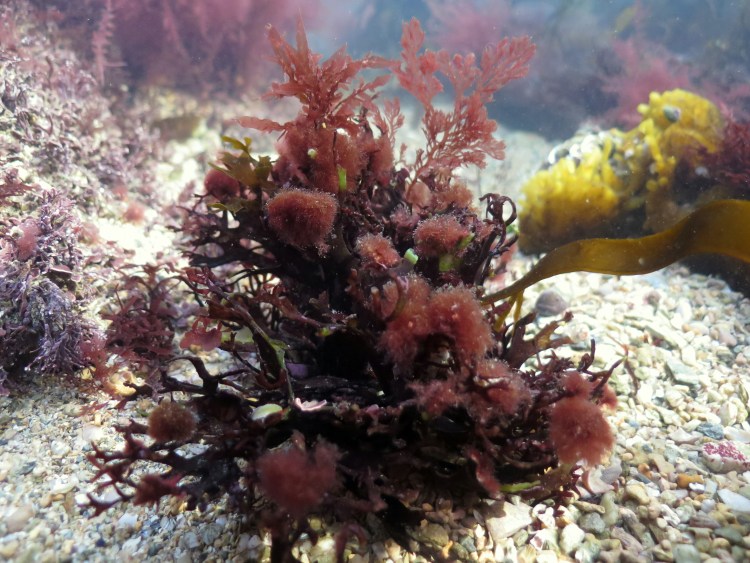
 The last time I went snorkelling, it was overcast and the tide was higher. I tried a bunch of shots a greater distance away to capture more of an overall impression, but with more water between the subject and the lens the shots become ‘milky’. The next shot of a whole variety of red, green and brown species (with Clawed fork weed Furcellaria lumbricalis in the middle) could have been really nice with clearer water, better framing and correct exposure! The next shot shows Cladostephus and Thong weed Himanthalia elongata on top of a rock covered with Red grape weed Gastroclonium ovatum (also on the last photo).
The last time I went snorkelling, it was overcast and the tide was higher. I tried a bunch of shots a greater distance away to capture more of an overall impression, but with more water between the subject and the lens the shots become ‘milky’. The next shot of a whole variety of red, green and brown species (with Clawed fork weed Furcellaria lumbricalis in the middle) could have been really nice with clearer water, better framing and correct exposure! The next shot shows Cladostephus and Thong weed Himanthalia elongata on top of a rock covered with Red grape weed Gastroclonium ovatum (also on the last photo). 

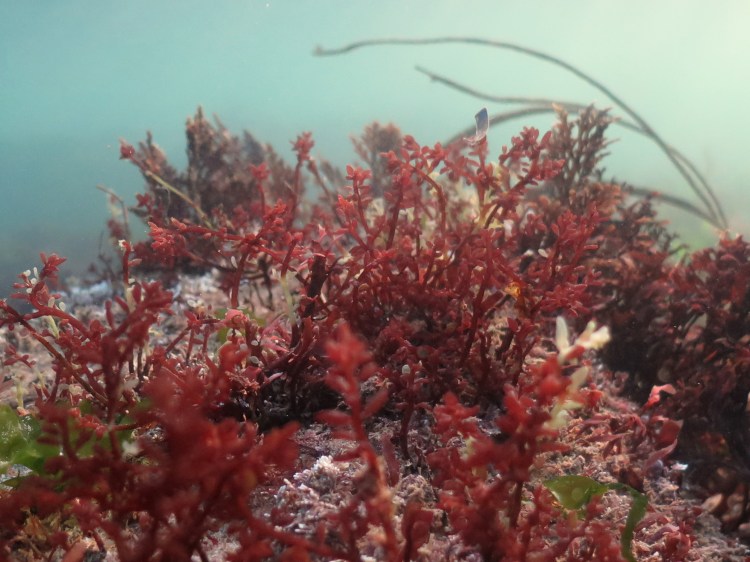
Oregon
 Last month we had a great holiday travelling from San Francisco to Seattle. Nature here is awe-inspiring for the average European; we saw snowcapped volcanoes, giant redwoods, dunes, beaches, mighty rivers and temperate rainforest. This is not the place for a travelogue, however, rock pools were of course checked and that is prime blog material! We had a bit of a happy-go-lucky approach to travelling and I had not checked tide times beforehand. Turns out that the tides on the Pacific West coast work very differently than those in Western Europe: instead of two almost equally low tides a day, there is a proper low tide and a not so low tide, how inconvenient! (This page has a good overview of tide types, including another type with only one low- and one high tide a day.) In the end I had two early mornings on the Oregon coast for rock pooling: Bob’s Creek Wayside south of Yachats (pic above) and Seal Rock north of Waldport (see map). (I actually prefer the more appropiate American term ‘tide pooling’ as of course there are also (freshwater) rock pools that do not experience tides.) The coast in most of Europe is so much more densely populated it is almost strange to see that vast stretches of pristine coastline with hardly any people around, brilliant. Also, the vast amounts of driftwood and logs is almost unseen in Europe, as thewhole continent is pretty much deforested (especially in the UK, my guess is only places like Norway could be comparable in that respect).
Last month we had a great holiday travelling from San Francisco to Seattle. Nature here is awe-inspiring for the average European; we saw snowcapped volcanoes, giant redwoods, dunes, beaches, mighty rivers and temperate rainforest. This is not the place for a travelogue, however, rock pools were of course checked and that is prime blog material! We had a bit of a happy-go-lucky approach to travelling and I had not checked tide times beforehand. Turns out that the tides on the Pacific West coast work very differently than those in Western Europe: instead of two almost equally low tides a day, there is a proper low tide and a not so low tide, how inconvenient! (This page has a good overview of tide types, including another type with only one low- and one high tide a day.) In the end I had two early mornings on the Oregon coast for rock pooling: Bob’s Creek Wayside south of Yachats (pic above) and Seal Rock north of Waldport (see map). (I actually prefer the more appropiate American term ‘tide pooling’ as of course there are also (freshwater) rock pools that do not experience tides.) The coast in most of Europe is so much more densely populated it is almost strange to see that vast stretches of pristine coastline with hardly any people around, brilliant. Also, the vast amounts of driftwood and logs is almost unseen in Europe, as thewhole continent is pretty much deforested (especially in the UK, my guess is only places like Norway could be comparable in that respect).

 Being at the Pacific Northwest tide pools made me feel like a kid in a sweetshop: I could not decide to stick with a beautiful find or try to move on to the next exciting thing. It seemed a bit useless to just start documenting all the different species in the short amount of time I had. Instead I mainly enjoyed just looking around, especially admiring the Green surf anemones Anthopleura xanthogrammica (above). I know this species mainly from the Coldwater Marine Aquarium Owner group on facebook which has many North American members. Although the diversity of animals and seaweeds in the South West of the UK is amazing, I must admit I am always a bit jealous of the critters in Pacific Northwest tanks! The Green surf anemones are not only strikingly coloured and large, but also incredibly common, along with the Aggregating anemone Anthopleura elegantissima forming dense carpets on the rocks, inhabiting gulleys low on the shore to tide pools quite high on the shore.
Being at the Pacific Northwest tide pools made me feel like a kid in a sweetshop: I could not decide to stick with a beautiful find or try to move on to the next exciting thing. It seemed a bit useless to just start documenting all the different species in the short amount of time I had. Instead I mainly enjoyed just looking around, especially admiring the Green surf anemones Anthopleura xanthogrammica (above). I know this species mainly from the Coldwater Marine Aquarium Owner group on facebook which has many North American members. Although the diversity of animals and seaweeds in the South West of the UK is amazing, I must admit I am always a bit jealous of the critters in Pacific Northwest tanks! The Green surf anemones are not only strikingly coloured and large, but also incredibly common, along with the Aggregating anemone Anthopleura elegantissima forming dense carpets on the rocks, inhabiting gulleys low on the shore to tide pools quite high on the shore.
I had taken the plunge and ordered a new camera for this holiday, a Canon G16 with a Fantasea underwater housing (see this post). However, I did feel comfortable with it in its bulky housing yet and so reverted to the more basic Canon powershot D30 and my iPhone for these sessions instead. I saw a couple of the large nudibranchs Hermissenda crassicornis as well as a Janolus fuscus, very pretty. Also below a Lined (or striped) shore crab Pachygrapsus crassipes and an unidentified prawn. Otherwise, most of the photo’s turned out to be not that great; I was just too hasty!


 Although all species were different (except for the Plumose anemones Metridium senile I saw on some pontoons), it was interesting to see the parallels with Cornish rock pools. For instance, all seaweed colours, shapes and textures I knew from home were present here, just in different combinations in each species. There were noticeable differences too. For one, many of the American organisms (chitons, isopods, anemones) are much bigger. The rocks were almost completely covered in barnacles and mussels (again both huge). Seagrass (Phyllospadix) was growing from the rocks!
Although all species were different (except for the Plumose anemones Metridium senile I saw on some pontoons), it was interesting to see the parallels with Cornish rock pools. For instance, all seaweed colours, shapes and textures I knew from home were present here, just in different combinations in each species. There were noticeable differences too. For one, many of the American organisms (chitons, isopods, anemones) are much bigger. The rocks were almost completely covered in barnacles and mussels (again both huge). Seagrass (Phyllospadix) was growing from the rocks!
Two mornings of rock pooling in a three week holiday was not enough, but all that was manageable unfortunately. We however also visited the Oregon Coast Aquarium in Newport on the single rainy day we had and that was pretty good. I am not a big fan of the generic aquarium displays (sharktunnels, ‘nemo’s’, scary Moray eels etc) so it was nice to see mainly coldwater aquaria, especially the nanoaquariums that housed a jumble of sponges, anemones, barnacles, chitons and strange fish, such as one of my favourites, the Grunt sculpin Rhamphocottus richardsonii which camouflages as a giant barnacle (first photo, see also here). A touch pool contained sea cucumbers, huge abalones and the largest chiton species in the world, the Giant Pacific (or Gumboot) chiton Cryptochiton stelleri, humongous! I hope one day to be back in this beautiful part of the world.



photographing seaweeds with a Canon Powershot part V
I have been a bit busy and so the photos below are some weeks old. The seaweeds are in decline already it seems. Actually, that is not true, there are plenty of seaweeds growing, but some of the prettier ones are dying off and some of the uglier ones are taking over. The window to take the nicest rock pool shots is quite short, pretty much early spring only. The ubiquitous False eyelash weed Calliblepharis jubata is yellowing, the green Sea lettuce Ulva lactuca is starting to cover everything and the Red grape weed is getting ‘fluffy’. Not the best session photo quality-wise and probably the last of the year. The Bushy rainbow wrack Cystoseira tamariscifolia is abundant and looking good (on the photo with Discoid forkweed Polyides rotundus) and I managed I nice shot of young Thong (or Spaghetti) weed Himanthalia elongata. I have done some more research into ‘proper’ underwater cameras and was tipped of about the Canon G16 (thanks Thomas from HydroMotion Media), maybe something for next year….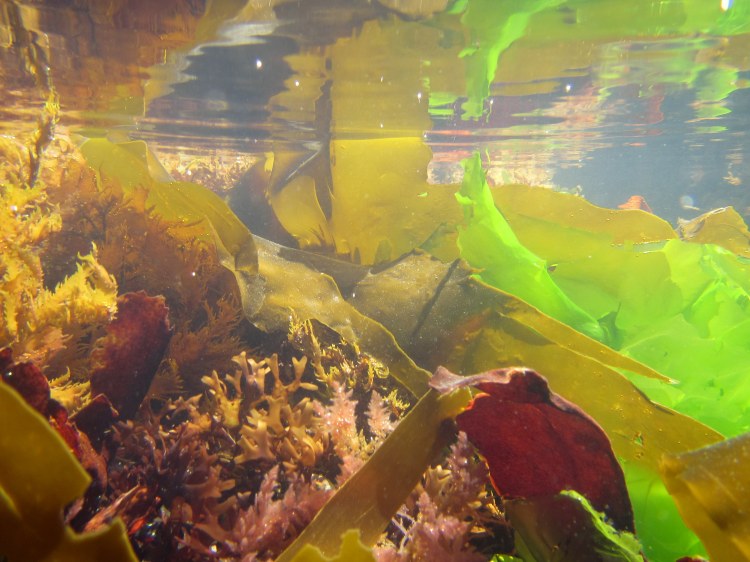



 The past couple of times when focusing on the seaweeds I also encountered some animals (it is hard not to). Many Snakelocks anemones Anemonia viridis, with some having very short tentacles. Next, a Decorator crab Macropodia rostrata covered in Banded pincer weed Ceramium. Mermaid’s purses (egg cases) of the Bull huss/Greater-spotted Dogfish/Large-spotted Catshark/Nursehound Scyliorhinus stellaris seem to be exclusively attached to Bushy rainbow wrack. Finally, a Stalked jellyfish Haliclystus octoradiatus on Wireweed Sargassum muticum.
The past couple of times when focusing on the seaweeds I also encountered some animals (it is hard not to). Many Snakelocks anemones Anemonia viridis, with some having very short tentacles. Next, a Decorator crab Macropodia rostrata covered in Banded pincer weed Ceramium. Mermaid’s purses (egg cases) of the Bull huss/Greater-spotted Dogfish/Large-spotted Catshark/Nursehound Scyliorhinus stellaris seem to be exclusively attached to Bushy rainbow wrack. Finally, a Stalked jellyfish Haliclystus octoradiatus on Wireweed Sargassum muticum.
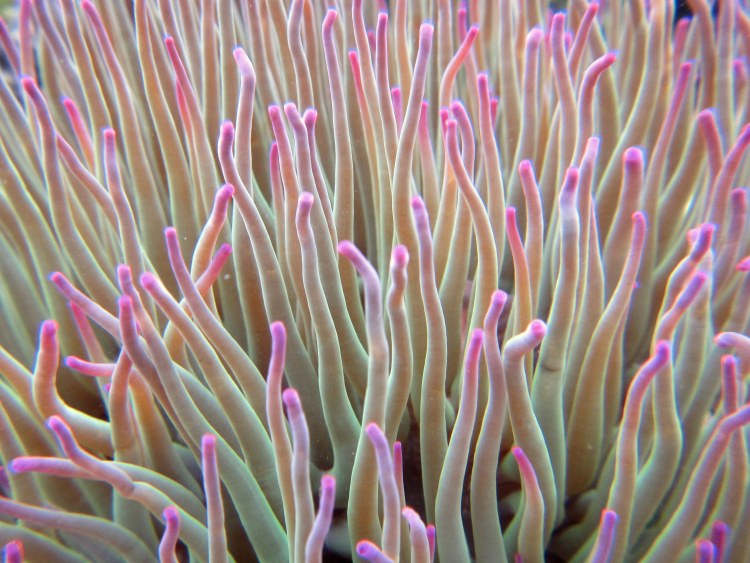


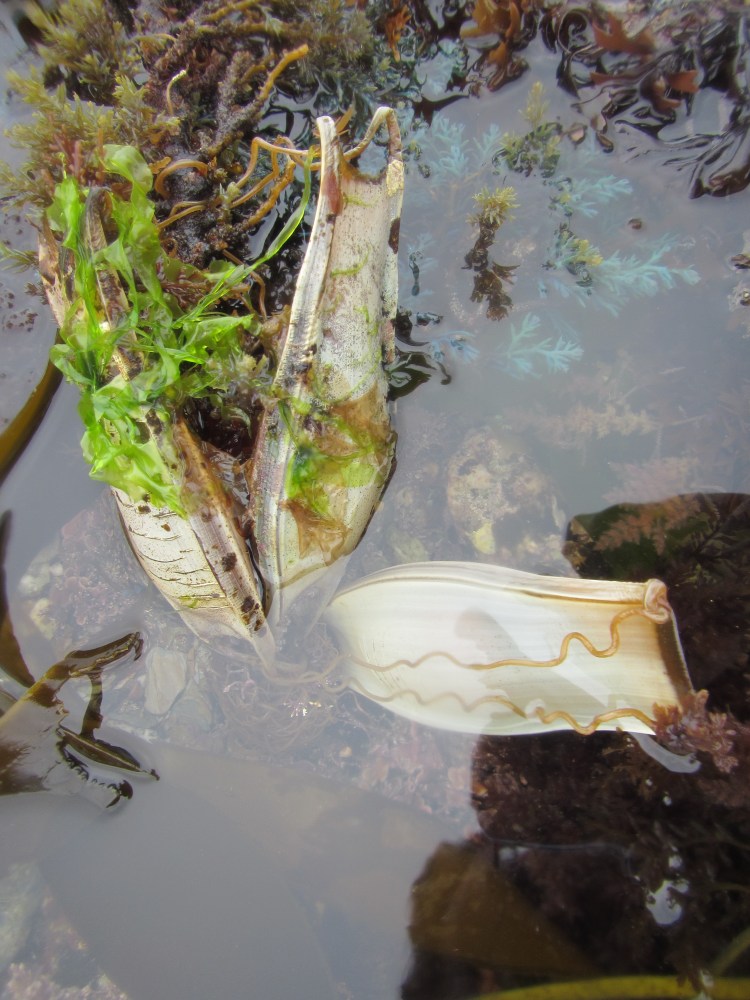


photographing seaweeds with a Canon Powershot part IV
All right then, another post with me fiddling around photographing seaweeds. Composition remains difficult; the next four photographs illustrate this. The diversity of colours and shapes compensate somewhat for it though. I think that a wide-angle lens is crucial to get better pictures: you can get close to the subject (important, as the water is not always crystal clear) whilst still getting a ‘panoramic’ view. Cameras such as the Sony RX100 in an underwater housing can be combined with such lenses (‘wet lenses’ which go on the housing rather than in). Camera, housing and a macro and wide-angle lens will set me back £1000 or so though, so maybe not. In any case there is still plenty room for improvement with the simple Canon Powershot, preventing overexposure for instance. I use Picasa to add some contrast, crop and straighten btw.


 Photographing through gulleys to create some depth makes things a bit more interesting (first picture). The second picture shows an overexposed background and a dark foreground but if properly exposed and in focus this sort of shot could be nice. Shots that are half reflection make things psychedelic and quite cool. This effect works well for Dumont’s tubular weed Dumontia contorta which is common highest up the shore (third picture). It is challenging to capture the beautiful blue-green colour of the Bushy rainbow wrack Cystoseira tamariscifolia as it is caused by iridescence, i.e. physical surface properties (see this old blog post from my work blog for some more info). It thus depends on the angle of view whether these beautiful colours can be seen. In the fourth picture you can see that the seaweed is a dull brown, but its reflection underneath the water surface does reveal the blue colour. The last picture demonstartes the different colours and textures well, but it is overexposed unfortunately.
Photographing through gulleys to create some depth makes things a bit more interesting (first picture). The second picture shows an overexposed background and a dark foreground but if properly exposed and in focus this sort of shot could be nice. Shots that are half reflection make things psychedelic and quite cool. This effect works well for Dumont’s tubular weed Dumontia contorta which is common highest up the shore (third picture). It is challenging to capture the beautiful blue-green colour of the Bushy rainbow wrack Cystoseira tamariscifolia as it is caused by iridescence, i.e. physical surface properties (see this old blog post from my work blog for some more info). It thus depends on the angle of view whether these beautiful colours can be seen. In the fourth picture you can see that the seaweed is a dull brown, but its reflection underneath the water surface does reveal the blue colour. The last picture demonstartes the different colours and textures well, but it is overexposed unfortunately.
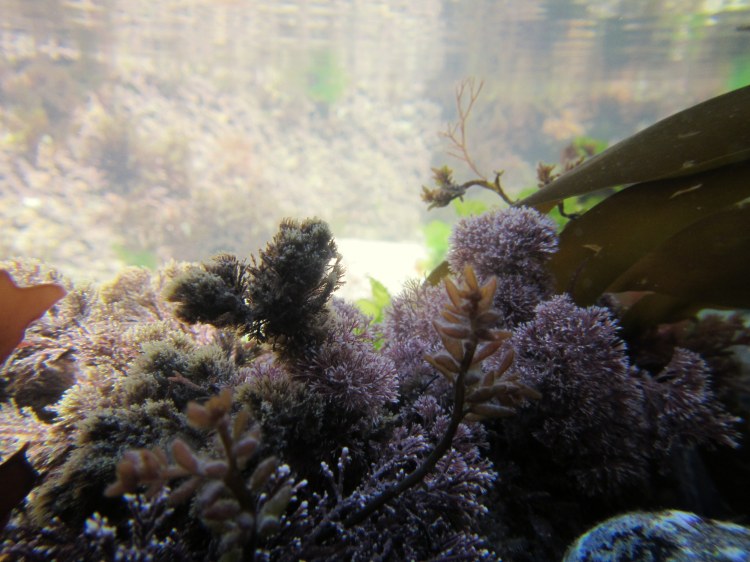
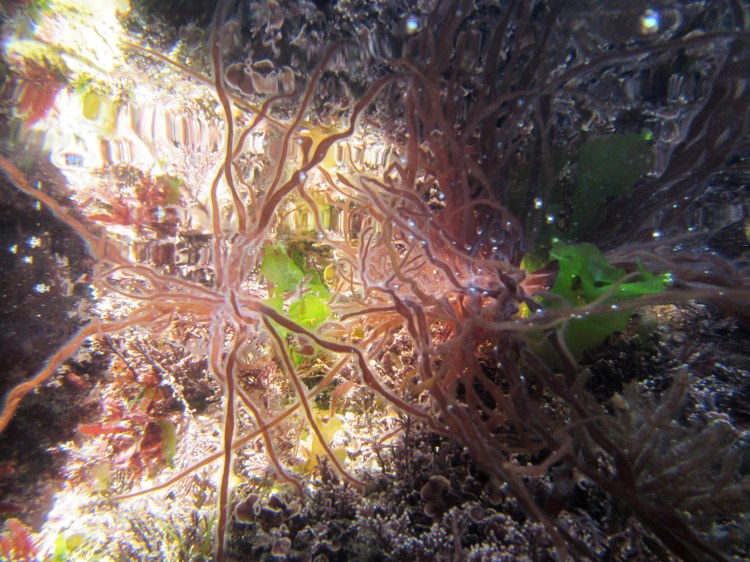
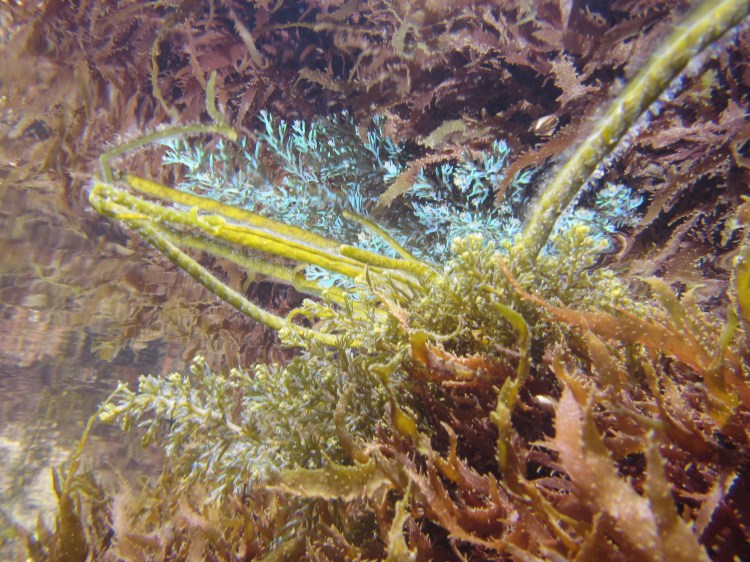
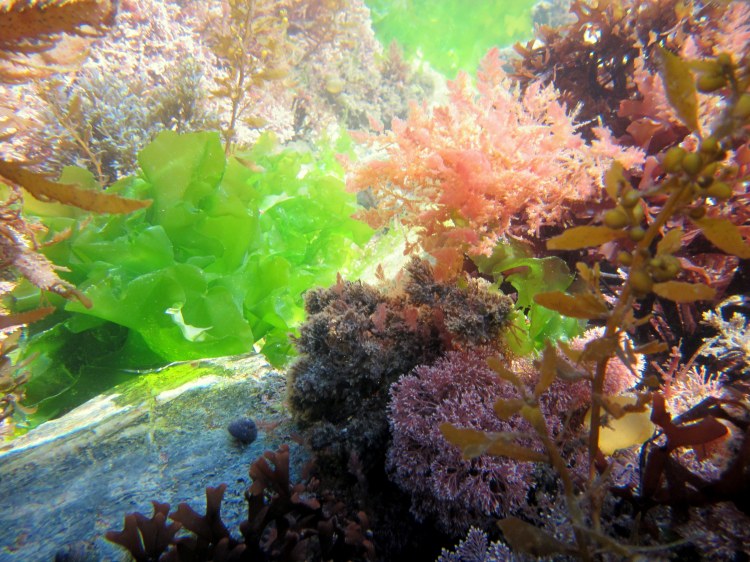
photographing seaweeds with a Canon Powershot part III
 Another couple of sessions trying to take seaweed photo’s. A couple of seaweed species are really thriving at the moment, one is False eyelash weed Calliblepharis jubata in the middle of the picture above. In the picture below a couple of other species, Irish moss Chondrus crispus in the foreground, Discoid forkweed Polyides rotundus on the left, Black scourweed Ahnfeltia plicata on the right, with some Red grape weed Gastroclonium ovatum at the top. Below that two ‘miscellanious’ pictures and after that some photos of individual species: the photo that turned out best was of Bonnemaison’s hook weed Bonnemaisonia hamifera, an invasive species from the Pacific. After that Juicy whorl weed Chylocladia verticilliata, a Plocamium species and my favourite, the Bushy rainbow wrack Cystoseira tamariscifolia.
Another couple of sessions trying to take seaweed photo’s. A couple of seaweed species are really thriving at the moment, one is False eyelash weed Calliblepharis jubata in the middle of the picture above. In the picture below a couple of other species, Irish moss Chondrus crispus in the foreground, Discoid forkweed Polyides rotundus on the left, Black scourweed Ahnfeltia plicata on the right, with some Red grape weed Gastroclonium ovatum at the top. Below that two ‘miscellanious’ pictures and after that some photos of individual species: the photo that turned out best was of Bonnemaison’s hook weed Bonnemaisonia hamifera, an invasive species from the Pacific. After that Juicy whorl weed Chylocladia verticilliata, a Plocamium species and my favourite, the Bushy rainbow wrack Cystoseira tamariscifolia.


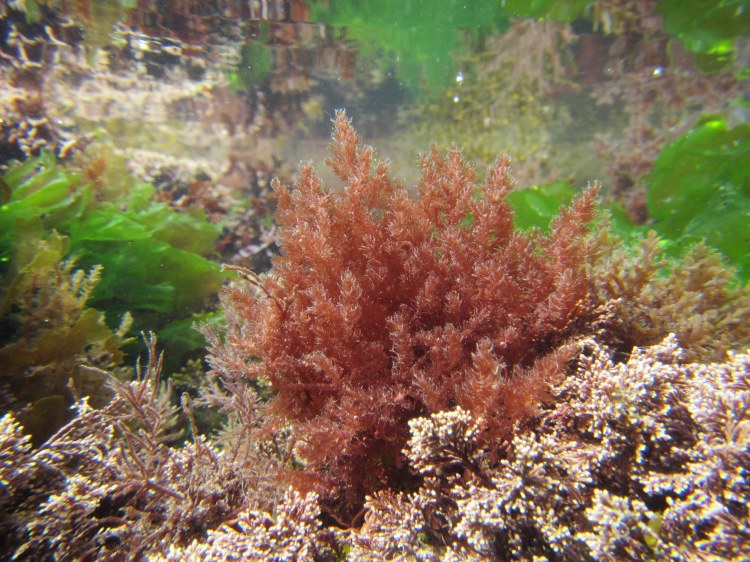
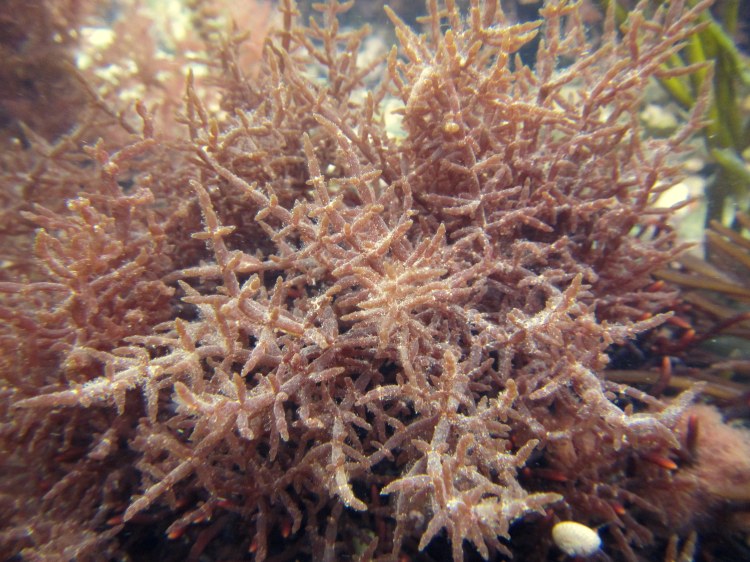


Pentire
 Three weeks back I had to pick someone up from Newquay airport and decided that it would be a good idea to combine that with some rock pooling action on the North Coast. I was told that the Pentire end of Fistral Beach was a good spot for Dahlia anemones and so the decision was made. Unfortunately I did not find any anemones, but it was a beautiful day nonetheless. The relatively few North coast sites I have explored all seem a bit barren in comparison to the South coast: more exposed, with sand meeting scoured rocks, leaving only hardy seaweeds, mussels and beadlet anemones to cling on. I need to spend some more time to find the right spots that’s for sure. The top of the cliff contained some rock pools, but they were quite milky due to the recent weather. They were full of the beautiful Brown tuning fork weed Bifurcata bifurcata (as I was on an anemone hunt, I was hasty and most photos did not come out especially nice, so see this old post for a nice photo of this species). The rocks were very slippery due to the (edible) Laver seaweed Porphyra (front of the next picture).
Three weeks back I had to pick someone up from Newquay airport and decided that it would be a good idea to combine that with some rock pooling action on the North Coast. I was told that the Pentire end of Fistral Beach was a good spot for Dahlia anemones and so the decision was made. Unfortunately I did not find any anemones, but it was a beautiful day nonetheless. The relatively few North coast sites I have explored all seem a bit barren in comparison to the South coast: more exposed, with sand meeting scoured rocks, leaving only hardy seaweeds, mussels and beadlet anemones to cling on. I need to spend some more time to find the right spots that’s for sure. The top of the cliff contained some rock pools, but they were quite milky due to the recent weather. They were full of the beautiful Brown tuning fork weed Bifurcata bifurcata (as I was on an anemone hunt, I was hasty and most photos did not come out especially nice, so see this old post for a nice photo of this species). The rocks were very slippery due to the (edible) Laver seaweed Porphyra (front of the next picture). At the base of the cliffs were some gullies, the largest of which is locally known by the rather grandiose name ‘Cave of Dreams’. No major finds here, but it was nice to see the many colour varieties of the Dog whelk Nucella lapillus (egg clusters in the background). The second photo is an especially pretty specimen; I only later noticed the green worm (probably Eulalia viridis) and the reflection in the beadlet anemone of me holding my iPhone! Beadlets are super common here. It is interesting that this species has two main colour varieties (red and green), just like the Snakelocks anemone (green and purplish) and the Plumose anemone (white and orange). This might be a coincidence but I find it intriguing. Lastly, some Sea pink or Thrift Armeria maritima.
At the base of the cliffs were some gullies, the largest of which is locally known by the rather grandiose name ‘Cave of Dreams’. No major finds here, but it was nice to see the many colour varieties of the Dog whelk Nucella lapillus (egg clusters in the background). The second photo is an especially pretty specimen; I only later noticed the green worm (probably Eulalia viridis) and the reflection in the beadlet anemone of me holding my iPhone! Beadlets are super common here. It is interesting that this species has two main colour varieties (red and green), just like the Snakelocks anemone (green and purplish) and the Plumose anemone (white and orange). This might be a coincidence but I find it intriguing. Lastly, some Sea pink or Thrift Armeria maritima.
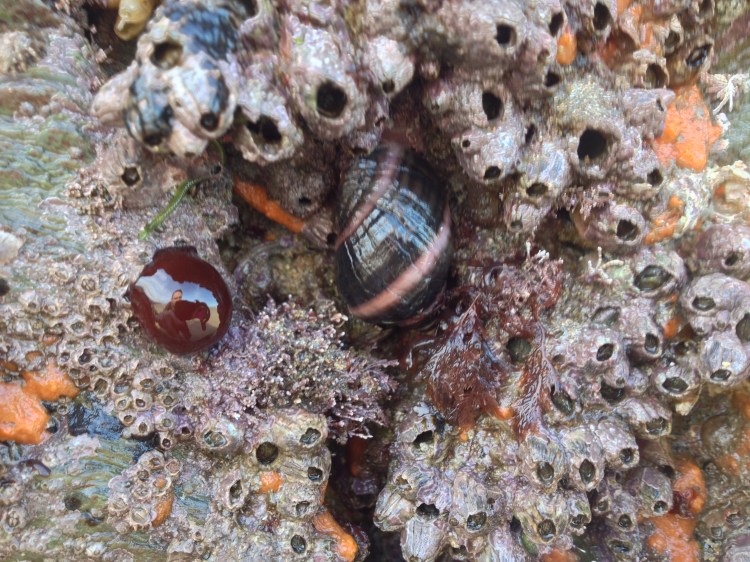


photographing seaweeds with a Canon Powershot part II
This friday, I tried my hand at some more underwater rock pool photography with my point-and-shoot Canon Powershot (see also here and here). This is both rewarding as the colours of seaweeds are so vivid and the textures so varied, and frustrating, as I cannot use the viewfinder and even if I could, lots of shots would be much better using a wider-angle lens. Also, I am often kicking up silt with my wellies and the nicest shots often are just out of reach. So next time, I should really photograph whilst snorkelling. (It would be great to use an SLR in an underwaterhousing. I bought a much cheaper and much more cumbersome ‘underwater-camera bag‘ without remembering that my old, not-so-frequently-used-anymore Canon EOS 400D does not have a viewfinder. I am afraid this will make the experience less, not more, fun…) Anyway, the trick for now is to take many pics and hope some turn out all right. I like the ones with a water surface reflection best. The nicest one was a snakelocks anemone among corraline algae. Next, what is may or may not be Sea flax weed Stypocaulon scoparium. After that, the brown Divided net weed Dictyota dichotoma growing inbetween Discoid fork weed Polyides rotundus, a Bull huss/Nursehound/Large-spotted dogfish Scyliorhinus stellaris mermaid’s purse and a Spiny starfish Marthasterias glacialis. Probably more photos soon as the pools look by far the best in early spring.
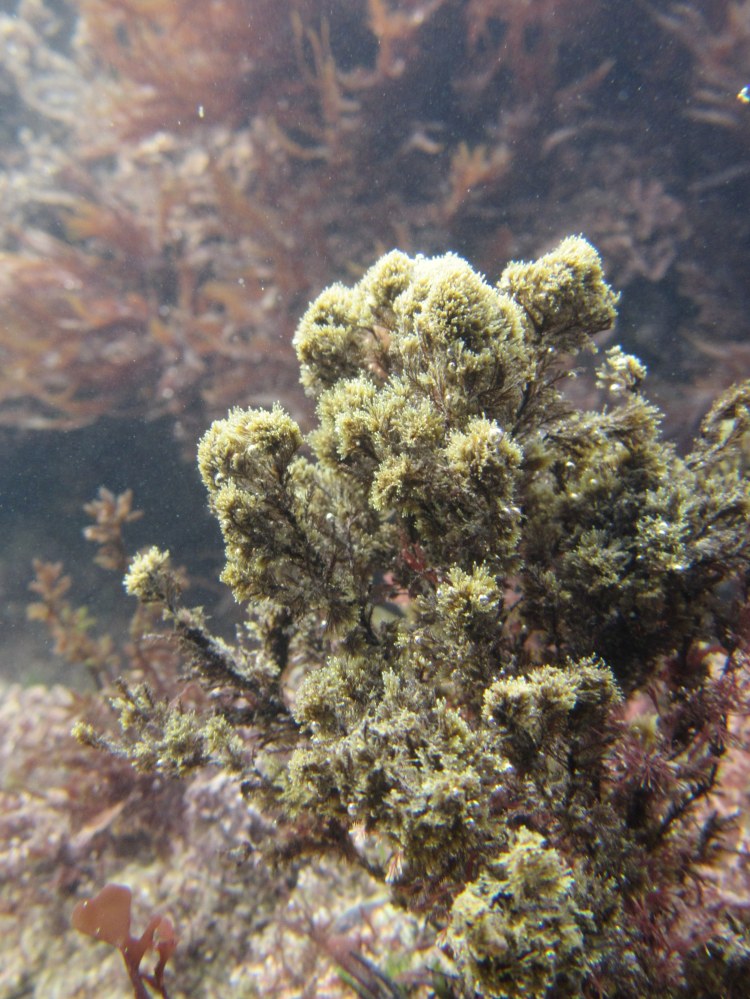
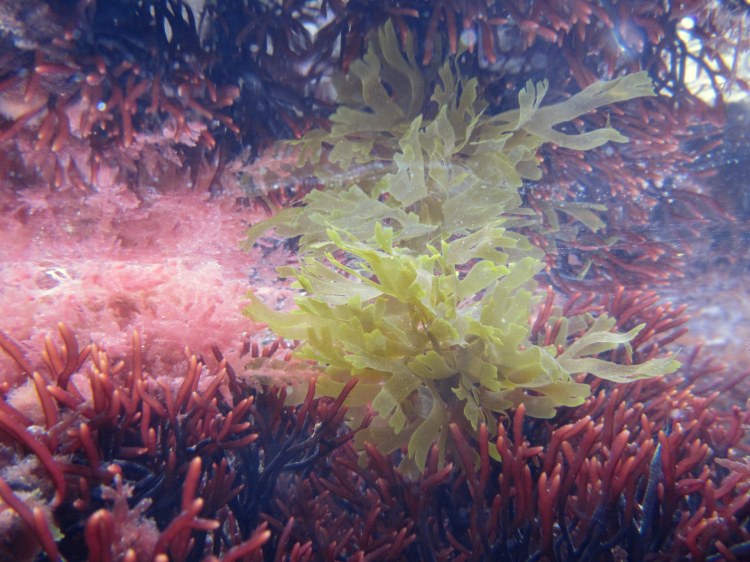
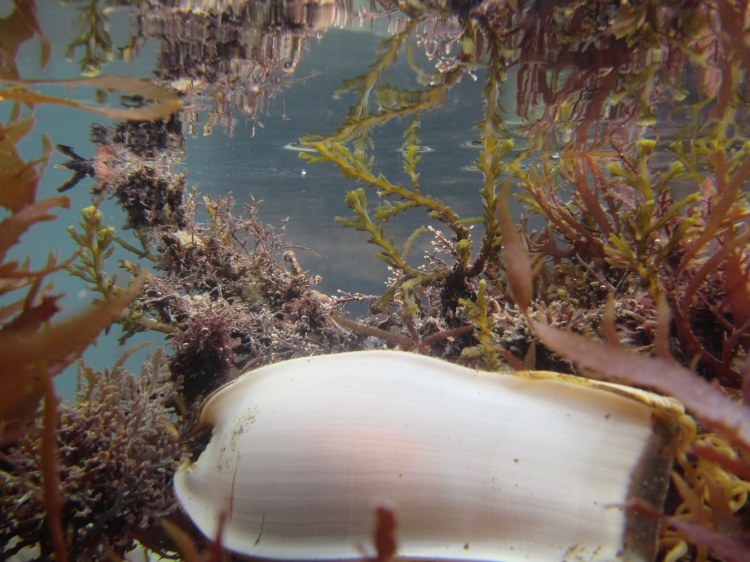

Leftover Pics
When going out rock pooling, I always take my iPhone and Canon Powershot (for underwater use) and take at least a couple of photos. Because of a lack of time, or because a single good photo is not enough for a new post, not everything ends up on the blog. Now I have some free time, I picked a couple of unused photos made this year that seem blog-worthy. First up, In realized only what I had found on the beach at St. Ives when leafing through the The Essential Guide to Beachcombing and the Strandline: a Seabeard! This hydroid, Nemertesia antennina, grows as stiff colonies protruding from a matted base and occasionally washes up on shore. It looks a bit plant-like; at the time I did not have the opportunity to have a closer look and just snapped a quick photo. Next a Lesser sandeel Ammodytes tobianus found at Gylly beach. I always see them when snorkeling or diving (see here) but this was a good opportunity to see one up close (I get excited when I spot a dead fish on the beach (see also here) and I am not afraid to admit it!). 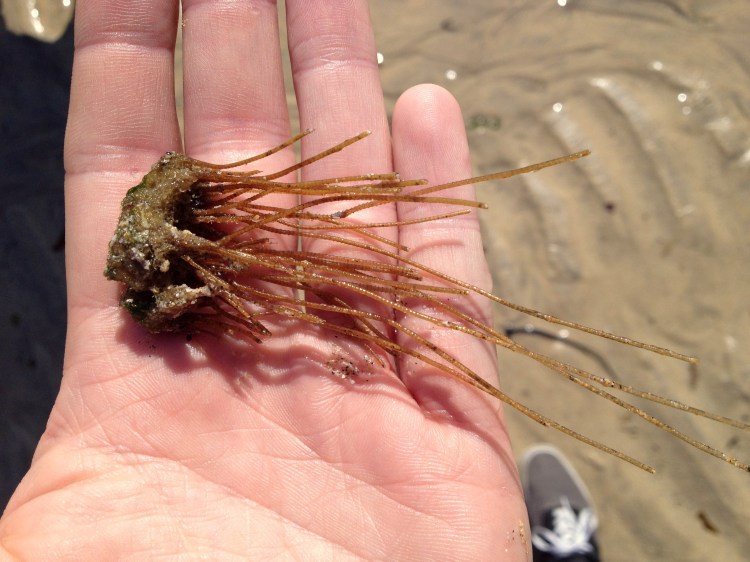

 Following are two colour varieties of the Spiny starfish Marthasterias glacialis, a Common brittlestar Ophiothrix fragilis and a shot of an Aequorea forskalea (or maybe A. vitrina) jellyfish. Next the gastropod mollusc Chinaman’s hat Calyptraea chinensis. I went back to Mylor marina for some pontooning recently but not much was growing; the only thing that stood out was the luxuriant sponge growth (I am not sure of the species, perhaps Halichondria).
Following are two colour varieties of the Spiny starfish Marthasterias glacialis, a Common brittlestar Ophiothrix fragilis and a shot of an Aequorea forskalea (or maybe A. vitrina) jellyfish. Next the gastropod mollusc Chinaman’s hat Calyptraea chinensis. I went back to Mylor marina for some pontooning recently but not much was growing; the only thing that stood out was the luxuriant sponge growth (I am not sure of the species, perhaps Halichondria).
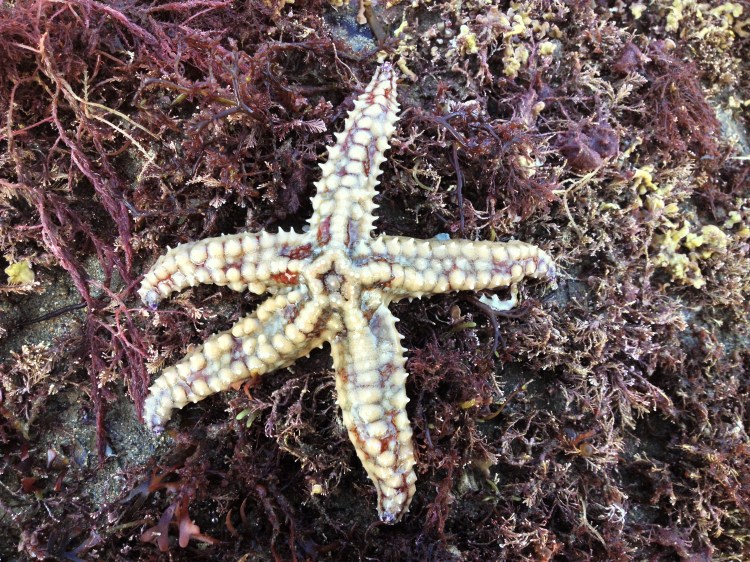



 And of course some seaweed pictures. By iPhone: Under tongue weed Hypoglossum hypoglossoides in Flushing, Black scour weed Ahnfeltia plicata in St. Agnes and a photo showing a variety of wracks all colonizing the same patch (Flushing): Serrated wrack Fucus serratus, Spiraled wrack Fucus spiralis, Bladderwrack Fucus vesiculosis and Egg wrack Ascophylum nodosum. Next some Canon Powershot underwater pics (see also this post and this one): a random rock pool picture of mostly decaying seaweed, a closeup of my favourite the Bushy rainbow wrack Cystoseira tamariscifolia and a shot of Wireweed Sargassum muticum that has completely taken over a pool. Finally an SLR photo of a rock pool at Gylly beach with large Cystoseira baccata plants (middle, Wireweed on the left).
And of course some seaweed pictures. By iPhone: Under tongue weed Hypoglossum hypoglossoides in Flushing, Black scour weed Ahnfeltia plicata in St. Agnes and a photo showing a variety of wracks all colonizing the same patch (Flushing): Serrated wrack Fucus serratus, Spiraled wrack Fucus spiralis, Bladderwrack Fucus vesiculosis and Egg wrack Ascophylum nodosum. Next some Canon Powershot underwater pics (see also this post and this one): a random rock pool picture of mostly decaying seaweed, a closeup of my favourite the Bushy rainbow wrack Cystoseira tamariscifolia and a shot of Wireweed Sargassum muticum that has completely taken over a pool. Finally an SLR photo of a rock pool at Gylly beach with large Cystoseira baccata plants (middle, Wireweed on the left).


